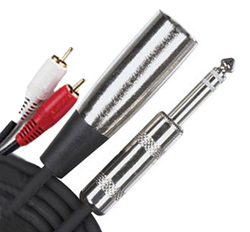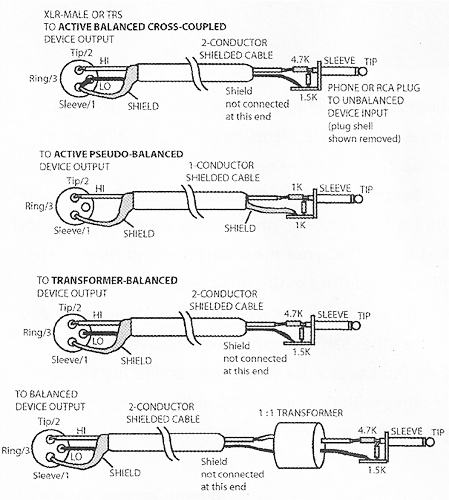
Using a transformer removes the shield connection between the two devices, so it breaks the ground loop and prevents hum.
Another way to prevent ground loops is to power the mixer and recorder from the same AC outlet strip, likely eliminating the need for a transformer.
If a console’s master output is a phone jack, consult the console owner’s manual to determine whether this jack is TS (tip-sleeve) or TRS (tip-ring-sleeve).
TS is unbalanced and -10 level; TRS is balanced and usually +4 level. If the TRS is -10, connect it directly to the recorder as shown in Figure 3.
MAKE IT CLEAR & EASY
Once the connecting cables are in place, be sure to label them – if they get pulled out, you’ll know where to plug them back in.
An alternative is to draw a diagram of the connections and place it at the mix position. But human nature being what it is, that diagram is quite likely to disappear. Better to label the cables directly.
To do this, purchase some rolls of masking tape and Sharpie-brand indelible marker pens. Label the end of each cable according to what it plugs into. For example, “Mixer Master Out” or “Recorder Ch. 1 In.”
It’s also a good idea to use bits of tape to mark the normal settings for the console controls. This way, the sound system is always operated optimally.
Also, consider putting a strip of tape along the bottom of the faders. On this strip, write what each fader correlates to, i.e., pastor’s lav microphone, singer’s wireless microphone, CD player, and so on.
A little time invested in things like careful labeling sure can make things so much easier when it’s “go time”.
You won’t be sorry for the extra effort.
AES and SynAudCon member Bruce Bartlett is a recording engineer, microphone engineer and audio journalist. His latest books are Practical Recording Techniques (5th Ed.) and Recording Music On Location.
More Church Sound articles by Bruce Bartlett:
Church Sound Recording 101: Start By Making The Right System Connections
Microphone Strategies That Produce Great Results With Church Choirs
Preventing “Hollow” Sound With Microphone Techniques
Identifying & Solving Microphone Problems

